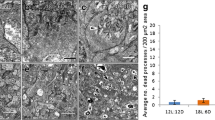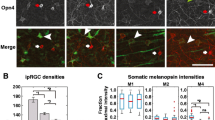Abstract
In pigeons as in other vertebrates, the electroretinogram (ERG) first can be recorded simultaneously with the appearance of the photosensitive lamellae in the developing outer segments. At around 4–6 days after the bird has hatched a small negative-positive complex (a-b-wave) appears. Simultaneously, a c-wave can be recorded and the termination of the stimulus is followed by a positive d-wave. The ERG amplitude progressively increases during the first month as the lamellar structures complete their maturation. The c-wave amplitude shows a steady increase in the early post-hatching period which parallels the a-b complex maturation. In newly hatched pigeons the retinal pigment epithelial (RPE) cell consists of a small soma and long villi which extend toward the photoreceptors. During maturation a progressive increase in RPE thickness and number of cytoplasmic elements can be observed.
Similar content being viewed by others
References
Bagnoli P, Porciatti V and Barsellotti R (1983) The development of spatial resolution in the pigeon retina. Perception 12:A20–21
Bagnoli P, Porciatti V, Lanfranchi A and Bedini C (1985) Developing pigeon retina: light-evoked responses and ultrastructure of outer segments and synopses. J Comp Neurol 235:384–394
Bischof HJ (1981) A stereotaxic head holder for small birds Brain Res Bull 7:435–436
Braekevelt CR (1984) Electron microscopic observations on the retinal pigment epithelium and choroid in the domestic pig (Sus scrofa). Zoomorphology 104:157–162
Granit R (1935) Two types of retinae and their electrical responses to intermittent stimuli in light and dark adaptation. J Physiol 85:421–438
Hanawa I, Takahashi K and Kawamoto N (1976) A correlation of embryogenesis of visual cells and early receptor potential in the developing retina. Exp Eye Res 23:587–594
Kikawada N (1968) Variations in the corneo-retinal standing potential of the vertebrate eye during light and dark adaptations. Jp J Physiol 18:687–702
Kuwabara T (1979) Species differences in the retinal pigment epithelium. In: The retinal pigment epithelium, eds: Zinn KM, Marmor MF. Cambridge, Harvard University Press, pp 58–82
Marmor MF and Lurie M (1979) Light-induced electrical responses of the retinal pigment epithelium. In: The retinal pigment epithelium, eds: Zinn KM, Marmor MF. Cambridge, Harvard University Press, pp 226–244
Matsuura T, Miller WH and Tomita T (1978) Cone-specific c-wave in the turtle retina. Vision Res 18:767–776
Nguyen-Legros J (1979) Fine structure of the pigment epithelium in the vertebrate retina. Int Rev Cytol 7:287–328
Oakley B II and Green DG (1976) Correlation of light-induced changes in retinal extracellular potassium concentration with c-wave of the electroretinogram. J Neurophysiol 39:1117–1133
Rager G (1979) The cellular origin of the b-wave in the electroretinogram: a developmental approach. J. Comp. Neurol. 188:225–244
Sato T (1969) The relation between the development of the electrical responses to the light and the electron micrographic structure of the visual cell in the chick's eye. J. Iwate Med. Assoc. 21:513–520
Steinberg RH, Schmidt R & Brown KT (1970) Intracellular responses to light from cat pigment epithelium: origin of the electroretinogram c-wave. Nature 227:728–730
Steinberg RH, Linsenmeier RA & Griff ER (1983) Three light-evoked responses of the retinal pigment epithelium. Vision Res. 23: 1315–1323
Tigges J, Brooks BA & Klee MR (1967) ERG recording of a primate pure cone retina (Tupaia glis). Vision Res. 7:553–562
Wioland N & Bonaventure N (1977) ERG components of the chicken retina. Doc. Ophtholmol Proc. Ser. 15:235–242
Wioland N & Bonaventure N (1984a) Evidence for both photopic and scotopic characteristics in the c-wave of chicken and frog ERG. Vision Res. 24:91–98
Wioland N & Bonaventure N (1984b) A cone-triggered c-wave in the chicken ERG: Pharmacological aspects. 22nd Symposium of the International Society for Clinical Electrophysiology of Vision, Stockholn
Witkovsky P (1963) An ontogenetic study of retinal function in the chick. Vision Res. 3:341–355
Author information
Authors and Affiliations
Rights and permissions
About this article
Cite this article
Porciatti, V., Bagnoli, P., Lanfranchi, A. et al. Interaction between photoreceptors and pigment epithelium in developing pigeon retina: an electrophysiological and ultrastructural study. Doc Ophthalmol 60, 413–419 (1985). https://doi.org/10.1007/BF00158932
Issue Date:
DOI: https://doi.org/10.1007/BF00158932




